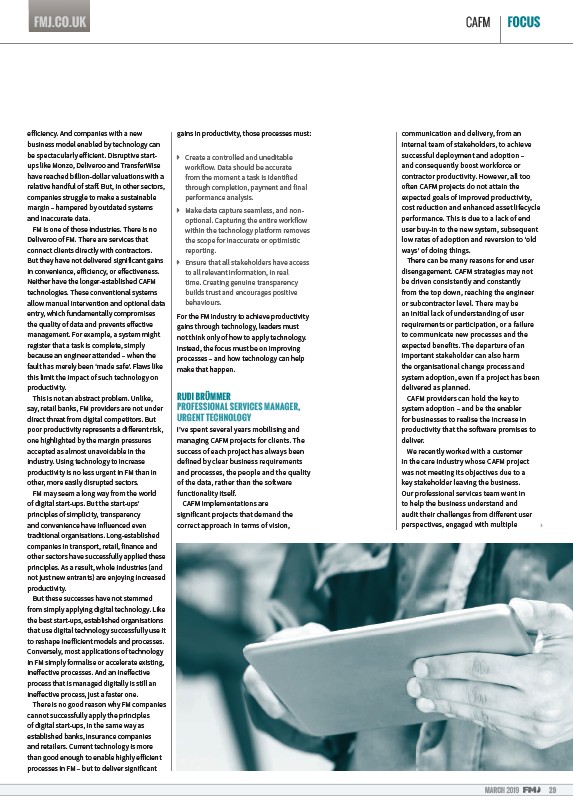
FMJ.CO.UK CAFM FOCUS
MARCH 2019 29
e iciency. And companies with a new
business model enabled by technology can
be spectacularly e icient. Disruptive startups
like Monzo, Deliveroo and TransferWise
have reached billion-dollar valuations with a
relative handful of sta . But, in other sectors,
companies struggle to make a sustainable
margin – hampered by outdated systems
and inaccurate data.
FM is one of those industries. There is no
Deliveroo of FM. There are services that
connect clients directly with contractors.
But they have not delivered significant gains
in convenience, e iciency, or e ectiveness.
Neither have the longer-established CAFM
technologies. These conventional systems
allow manual intervention and optional data
entry, which fundamentally compromises
the quality of data and prevents e ective
management. For example, a system might
register that a task is complete, simply
because an engineer attended – when the
fault has merely been ‘made safe’. Flaws like
this limit the impact of such technology on
productivity.
This is not an abstract problem. Unlike,
say, retail banks, FM providers are not under
direct threat from digital competitors. But
poor productivity represents a di erent risk,
one highlighted by the margin pressures
accepted as almost unavoidable in the
industry. Using technology to increase
productivity is no less urgent in FM than in
other, more easily disrupted sectors.
FM may seem a long way from the world
of digital start-ups. But the start-ups’
principles of simplicity, transparency
and convenience have influenced even
traditional organisations. Long-established
companies in transport, retail, finance and
other sectors have successfully applied these
principles. As a result, whole industries (and
not just new entrants) are enjoying increased
productivity.
But these successes have not stemmed
from simply applying digital technology. Like
the best start-ups, established organisations
that use digital technology successfully use it
to reshape ine icient models and processes.
Conversely, most applications of technology
in FM simply formalise or accelerate existing,
ine ective processes. And an ine ective
process that is managed digitally is still an
ine ective process, just a faster one.
There is no good reason why FM companies
cannot successfully apply the principles
of digital start-ups, in the same way as
established banks, insurance companies
and retailers. Current technology is more
than good enough to enable highly e icient
processes in FM – but to deliver significant
gains in productivity, those processes must:
Create a controlled and uneditable
workflow. Data should be accurate
from the moment a task is identified
through completion, payment and final
performance analysis.
Make data capture seamless, and nonoptional.
Capturing the entire workflow
within the technology platform removes
the scope for inaccurate or optimistic
reporting.
Ensure that all stakeholders have access
to all relevant information, in real
time. Creating genuine transparency
builds trust and encourages positive
behaviours.
For the FM industry to achieve productivity
gains through technology, leaders must
not think only of how to apply technology.
Instead, the focus must be on improving
processes – and how technology can help
make that happen.
RUDI BRÜMMER
PROFESSIONAL SERVICES MANAGER,
URGENT TECHNOLOGY
I’ve spent several years mobilising and
managing CAFM projects for clients. The
success of each project has always been
defined by clear business requirements
and processes, the people and the quality
of the data, rather than the so„ ware
functionality itself.
CAFM implementations are
significant projects that demand the
correct approach in terms of vision,
communication and delivery, from an
internal team of stakeholders, to achieve
successful deployment and adoption –
and consequently boost workforce or
contractor productivity. However, all too
o„ en CAFM projects do not attain the
expected goals of improved productivity,
cost reduction and enhanced asset lifecycle
performance. This is due to a lack of end
user buy-in to the new system, subsequent
low rates of adoption and reversion to ‘old
ways’ of doing things.
There can be many reasons for end user
disengagement. CAFM strategies may not
be driven consistently and constantly
from the top down, reaching the engineer
or subcontractor level. There may be
an initial lack of understanding of user
requirements or participation, or a failure
to communicate new processes and the
expected benefits. The departure of an
important stakeholder can also harm
the organisational change process and
system adoption, even if a project has been
delivered as planned.
CAFM providers can hold the key to
system adoption – and be the enabler
for businesses to realise the increase in
productivity that the so„ ware promises to
deliver.
We recently worked with a customer
in the care industry whose CAFM project
was not meeting its objectives due to a
key stakeholder leaving the business.
Our professional services team went in
to help the business understand and
audit their challenges from di erent user
perspectives, engaged with multiple